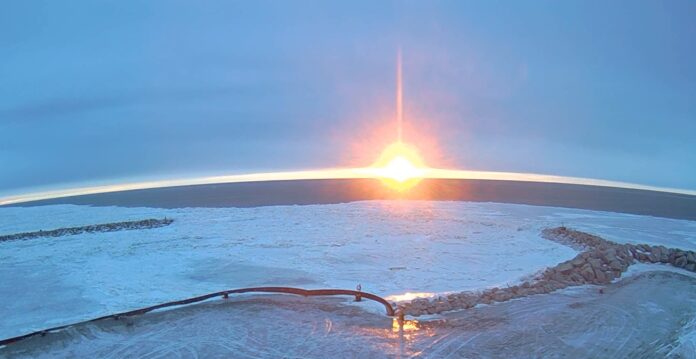
The Nome Volunteer Fire Department reported Friday morning that overnight searches by crews on two C130 planes found no trace of the Bering Air Cessna Caravan plane that had 10 on board when it went missing over Norton Sound on Thursday afternoon.
The flight transmitter stopped sending signals at about 3:19 p.m., and it appears the plane was over water or young (not thick) ice in the sound that is between Unalakleet, where the flight originated, and Nome, the carrier’s destination.
The Federal Bureau of Investigation on Friday is going to attempt to trace the cell phones of those onboard, although if the plane is in the water, that may not be easy. The plane itself has not transmitted any detectable signal by its emergency locator transmitter, a device that typically activates if a plane crashes.
Nome Fire Department said the Alaska National Guard has been approved to fly and has launched in a Blackhawk helicopter, and the U.S. Coast Guard is bringing a helicopter from Kodiak. Another C-130 has landed in Nome to assist. A ground crew is heading down the coast from Nome toward where the plane might be spotted.
Bering Air is ready to launch a King Air and helicopter support, but is letting Coast Guard maintain the airspace, the fire department said.
“All families of passengers on the missing flight have been notified. Please keep families in your thoughts at this time. Search efforts continue by air and land. The Coast Guard helicopter is actively canvassing the sea ice and shoreline, and the National Guard is spooling up to launch in the Blackhawk,” the fire department wrote on Friday.
This story will be updated as facts emerge.
Feb. 7, 10:30 a.m. update from Nome Volunteer Fire Department: “We received a weather update from National Weather Service this morning, and weather is looking stable for the next 24 hours to continue air search. Bering Air launched two King Airs earlier today at first light to fly grid patterns to canvas the area. Two helicopters are loading up to go in 20 Minutes. The Coast Guard is planning to drop a buoy to track and monitor ice movement to inform the search. The International Guard will help with searching in their helicopter. Search and Rescue groups from White Mountain and Nome continue to search by land in the surrounding area.”
Read the original report and updates from Thursday night at the link below:
Thank you, Suzanne, for your timely and concise reporting.
In this day and age of tracking technology, if a plane cannot be found it is because someone doesn’t want it to be found.
What are you trying to say Sky?
My guess is that you are not familiar with modern day aircraft and their communication capabilities.
If the Cessna 208 crashed but was on top of the ice or the ground the emergency locator beacon would transmit its location. Satellites also can be used to target an aircraft. But if the plane is under the water there would be no transmissions to assist in locating it.
Your paranoid comment is not very realistic and certainly not helpful.
Great reporting, Suzanne. How far offshore does the ice extend? If in open water, the search will be difficult in February.
Right now, RonD, sea ice that is hugging the shore extends about 1/2 mile out, and beyond that it may be slushy or weak. Press conference from agencies at noon. – sd
Suzanne,
Are you willing to provide a report as well about WHO is searching?
From what I know there aren’t a lot of government affiliated entities who are part of the search… it comes across as most of the entities spearheading this are privately owned. The OTHER medias are reporting something different about a large search underway but it is important to report the truth in this regard. The large search is being run predominantly by family members, and local aviation- not the military or other rescue groups as being portrayed in other platforms. I’d like to ensure those who are searching are given accolades for doing so, and not on the back of an absent, tax paid, bureaucracy.
HM I’ve been monitoring the flight radar and have seen National Guard, Coast Guard, Army assets flying search patterns. Also working are State Troopers, local search and rescue, family and friends. In rural Alaska, it is all hands on deck. The city has opened the road to the east for ground searchers. Bering Air is making its assets like King Air available, weather depending. These searches are coordinated by a central command structure to ensure safety. Today is an important day, with good visibility. Weather may hamper efforts tomorrow. Keep in mind that it gets dark early there and first light wasn’t until 9:30 a.m. The daylight and weather are going to be limiting factors. Thank you, – sd
We at MRAK pray for their souls.